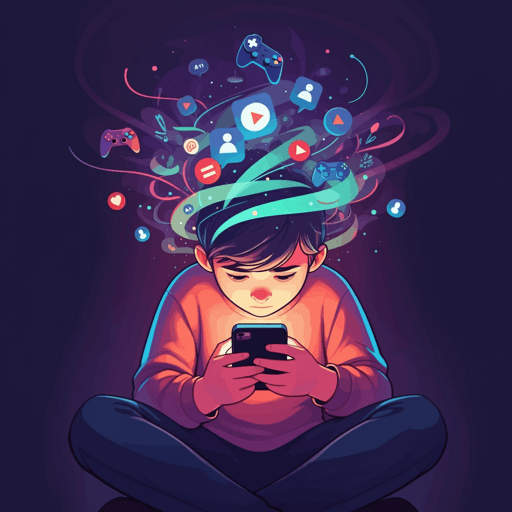
Medicine and Health
Associations of time spent on different types of digital media with self-rated general and mental health in Swedish adolescents
H. Frielingsdorf, V. Fomichov, et al.
Adolescents who spend 4–5+ hours daily on digital media—especially watching movies/series/video clips—show higher rates of poor self-esteem, low mood/depression, sleep problems and physical pain, with very high use (≥6 h/day) linked to anxiety, poor general health and low trust. This cross-sectional study of 3,566 Swedish 16–17-year-olds found dose–response associations that emerge after 4–5 hours. The research was conducted by Authors present in <Authors> tag.
~3 min • Beginner • English
Introduction
Adolescent mental health problems have increased globally, including in Sweden, raising concerns about factors that may contribute to poor mental health and general health in this age group. Concurrently, adolescents’ use of digital media has surged and diversified, with most Swedish adolescents using smartphones and spending substantial time on social platforms, streaming content, and gaming. Digital media can have both positive and negative effects on well-being, but precise thresholds for potentially harmful use remain unclear, and effects may differ by media type (interactive vs passive). The study investigates how time spent on distinct categories of digital media (social media, gaming, watching movies/series/video clips, and digital schoolwork) relates to self-reported general and mental health outcomes (general health, self-esteem, worry/anxiety, low mood/depression, trust, head/neck/shoulder pain, and sleep) among Swedish adolescents, aiming to identify potential dose–response relationships and usage thresholds associated with adverse outcomes.
Literature Review
Prior research has linked higher screen time with poorer sleep and depressive symptoms in longitudinal analyses, and social media with poorer body image. Cross-sectional studies report that more than 2–4 hours/day of total screen time is associated with adverse health indicators including overweight, musculoskeletal pain, and symptoms of depression/anxiety, and that social media use is associated with depression, anxiety, and poor sleep. Gaming >2 hours/day has been linked to depressive symptoms and, variably, to overweight and poor sleep. Screen time has also been associated with poorer self-rated general health, which predicts later outcomes, and with trust in others, which relates to health behaviors and health status. Evidence suggests the effects may depend on media type and content (passive vs active), and displacement effects where screen time reduces sleep, activity, and schoolwork. Meta-analyses report mixed thresholds for adverse effects, with some studies showing impacts after 0.5 hours/day and others after 3.5 hours/day, highlighting the need for more precise cut-offs and context-specific analyses. Socioeconomic and lifestyle factors may moderate these relationships, but are understudied.
Methodology
Design: Cross-sectional, population-based analysis using the annual web survey "Om mig" (About Me) administered in Östergötland County, Sweden, to 2nd-year high school students (typically 16–17 years old) during September 16–October 25, 2019. Participation occurred during school hours or free time and was anonymous and voluntary.
Participants and setting: 41 of 58 high schools (71%) administered the survey. Of 4139 adolescents who agreed to participate (75% response rate), 573 lacking complete digital media data were excluded, yielding n=3566 for analysis. Demographics: 49.8% girls (n=1769), 49.2% boys (n=1749), 1.0% other gender (n=35); 76.0% Swedish origin (n=2701); 78.9% reported good family finances.
Measures – digital media time: Based on adolescent-informed development and pilot testing, daily time was reported for four categories: social media; watching movies/series/video clips; gaming; digital schoolwork. Original nine-point response scale: not at all, 30 min, 1 h, 2 h, 3 h, 4 h, 5 h, 6 h, 7 h or more. Re-categorized as low (≤1 h), moderate (2–3 h), high (4–5 h), very high (≥6 h). Data from all individuals were included regardless of total screen time.
Health outcomes: Self-rated general health (very good/good/fair/poor/very poor) and sleep (very good/quite good/quite poor/very poor) dichotomized into poor vs not poor. Self-esteem (always/often/sometimes/rarely/never) dichotomized into poor (rarely/never) vs not poor. Trust in other people (a lot/quite a lot/fairly little/a little) dichotomized into low vs not low. Frequency of daily symptoms (almost daily vs less) assessed for worry/anxiety, low mood/depression, headache, and neck/shoulder pain over an approximate 4–10 week recall period.
Covariates: Sociodemographics: gender (male/female/other), high school program (college preparatory/vocational/introductory/other), origin (Swedish vs non-Swedish), family finances (good vs not good). Health behaviors: physical activity (≥1 h moderate–vigorous per day, ≥5 days/week), regular meals (daily breakfast and lunch), daily tobacco use, weekly alcohol consumption; all dichotomized.
Statistical analyses: Descriptive statistics (means, proportions, frequencies); pairwise t-tests with Bonferroni adjustment; chi-squared tests, 5% significance. Logistic regression models estimated odds ratios (ORs) with 95% CIs for each health outcome across digital media time categories, using ≤1 h/day as the reference. Models: Univariate (unadjusted), Model A (adjusted for sociodemographics), Model B (adjusted for sociodemographics + health behaviors). Gender interaction terms were tested; no significant interactions were found, so pooled results are presented. Analyses performed in IBM SPSS Statistics 27. Ethics approval: Swedish Ethical Review Authority (Dnr 2014/298-31; Dnr 2021-04953).
Key Findings
Sample and usage:
- Final sample: n=3566 adolescents (16–17 years). 76% Swedish origin; 78.9% reported good family finances.
- Average daily use (means, SD): social media girls 3.24 h (1.85) vs boys 2.62 h (1.89); movies/series/video clips girls 2.67 h (1.73), boys 2.50 h (1.67); schoolwork girls 2.85 h (2.06), boys 2.31 h (1.67); gaming boys 2.37 h (2.00), girls 0.77 h (1.42). Participants of other genders reported high usage across categories.
- Time category distributions: social media moderate/high/very high 74.1%; movies/series/video clips 71.1%; schoolwork 60.8%; gaming low 63.2% with 32.8% reporting none. 73% spent ≥3 h/day on at least one leisure digital media type; 10.1% spent ≥3 h/day on each of social media, videos, and gaming; 1.4% spent ≥6 h/day on each, indicating simultaneous use.
Associations (selected adjusted results):
- Social media: Very high time (≥6 h/day) remained associated after full adjustment (Model B) with poor self-esteem, daily worry/anxiety, daily low mood/depression, daily headache/neck/shoulder pain, and poor sleep (ORs ~1.35–1.64; 95% CIs ~1.02–2.30). High time (4–5 h/day) associated with daily worry/anxiety, daily low mood/depression, and daily headache/neck/shoulder pain (unadjusted ORs ~1.38–1.48). Moderate use (2–3 h/day) showed weak or no associations.
- Watching movies/series/video clips: After Model B, ≥6 h/day associated with poor general health, poor self-esteem, daily low mood/depression, low trust, daily headache/neck/shoulder pain, and poor sleep (ORs 1.50–2.25; CIs 1.06–3.22), except daily worry/anxiety (not significant). High time (4–5 h/day) associated with daily low mood/depression (OR 1.46, CI 1.06–1.99), low trust (OR 1.32, CI 1.05–1.65), and daily neck/shoulder pain (OR 1.41, CI 1.09–1.82).
- Digital schoolwork: Moderate and high time were not associated with adverse outcomes. Very high time (≥6 h/day) associated with daily neck/shoulder pain (unadjusted OR 2.22, CI 1.79–2.79; Model A OR 1.90, CI 1.48–2.43; Model B OR 1.44, CI 1.06–1.95) and with poor self-esteem (unadjusted OR 1.57, CI 1.19–2.07), with only weak attenuation after adjustment.
- Gaming: Very high time (≥6 h/day) associated (unadjusted) with all adverse outcomes except daily neck/shoulder pain (ORs 1.53–3.34), strongest for poor self-rated health (OR 3.34) and poor sleep (OR 2.74). Moderate (2–3 h) and high (4–5 h) time showed minimal associations except for poor sleep (ORs 1.26 and 1.96). Adjusted models showed gaming associations relatively unaffected by covariate adjustment.
Overall pattern: A dose–response relationship emerged, with adverse associations appearing at 4–5 h/day and strengthening at ≥6 h/day, particularly for watching movies/series/video clips. Digital schoolwork exhibited minimal adverse associations except musculoskeletal pain at very high exposure.
Discussion
The study addressed whether time spent on specific digital media categories relates to adolescents’ self-rated general and mental health. Findings show consistent dose–response associations: adverse outcomes generally begin to appear at 4–5 h/day and are stronger at ≥6 h/day, particularly for watching movies/series/video clips. Social media and gaming also show associations, though gaming’s associations were less attenuated by sociodemographic and health behavior adjustments, suggesting potentially more robust links for certain outcomes (e.g., poor general health, poor sleep). Adjustments for health behaviors and socioeconomic covariates attenuated many associations, especially for social media and video watching, indicating that healthy lifestyles and socioeconomic prosperity may mitigate some adverse effects. However, very high exposure (≥6 h/day) often remained significantly associated with adverse outcomes, implying limited mitigation at extreme usage levels. The minimal adverse associations for digital schoolwork (apart from neck/shoulder pain) support the notion that content and mode of use (passive vs active) and displacement effects (sleep, physical activity, schoolwork) may be key mechanisms. The findings underscore the need for nuanced public health recommendations emphasizing balanced use, attention to passive consumption, and lifestyle factors.
Conclusion
This population-based study of Swedish adolescents demonstrates a dose–response relationship between time spent on digital media and adverse self-rated general and mental health outcomes. Very high use (≥6 h/day) of social media, gaming, and watching movies/series/video clips was associated with multiple adverse outcomes even after adjustment for sociodemographics and health behaviors, while high use (4–5 h/day) of watching videos was also linked to specific adverse outcomes. Digital schoolwork showed minimal adverse associations except musculoskeletal pain at very high exposure. The results provide practical guidance on usage thresholds linked to adverse effects and highlight the importance of healthy, balanced digital media use. Future research should include longitudinal studies and randomized controlled trials to assess causality and the impact of reducing specific media types on health. Public health interventions targeting healthy digital habits, sleep, physical activity, and socioeconomic inequities are warranted.
Limitations
Cross-sectional design precludes causal inference and raises the possibility of bidirectional relationships between digital media use and health. Reliance on self-reported measures may introduce recall bias and inaccuracies in estimating time use. The survey focused on four primary digital media categories and did not capture other uses (e.g., online shopping, general web browsing) or differences between weekdays and weekends, potentially limiting granularity. Some adolescents may multitask across media, complicating total exposure estimates; a small proportion reported implausibly high total daily usage (≥24 h), indicating simultaneous use. Missing data led to exclusion of 573 individuals, and excluded participants differed in gender, origin, family finances, and program type, which may introduce selection bias. Although validated and widely used question formats were employed for general and mental health, measurement limitations remain.
Related Publications
Explore these studies to deepen your understanding of the subject.







